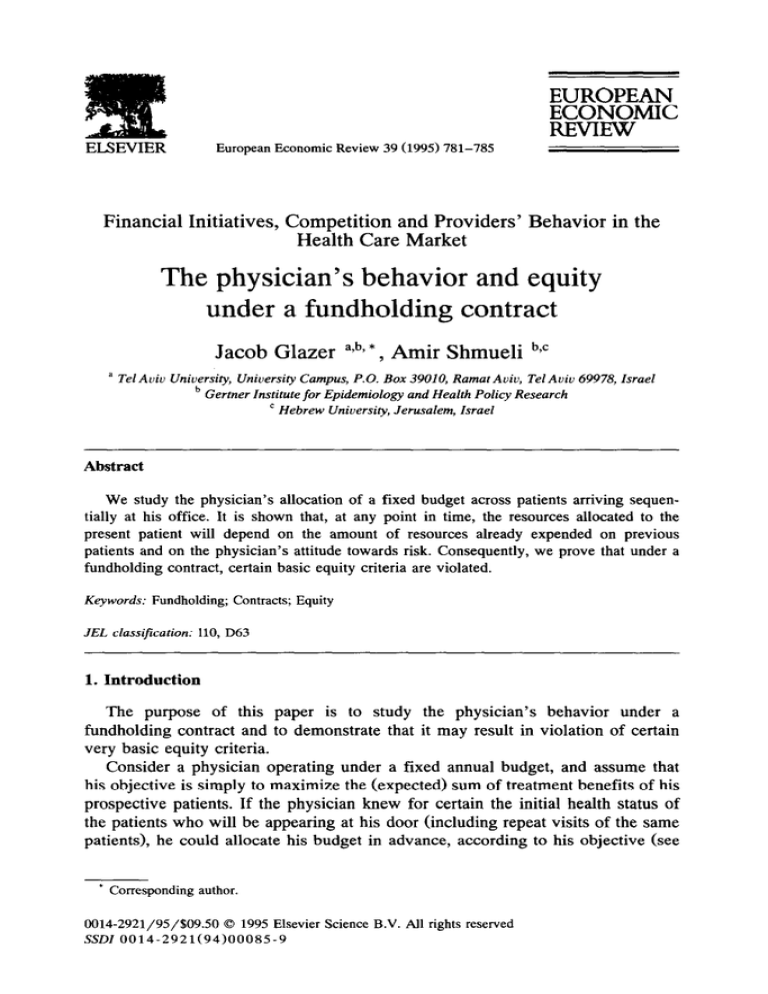
EUROPEAN
F6i%i%GMC
ELSEVIER
European Economic
Review 39 (1995) 781-785
Financial Initiatives, Competition and Providers’ Behavior in the
Health Care Market
The physician’s behavior and equity
under a fundholding contract
Jacob Glazer apby
*, Amir Shmueli b,c
a Tel Aviv University, University Campus, P.O. Box 39010, Ramat Aviv, Tel Aviv 69978, Israel
b Gertner Institute for Epidemiology and Health Policy Research
’ Hebrew University, Jerusalem, Israel
Abstract
We study the physician’s allocation of a fixed budget across patients arriving sequentially at his office. It is shown that, at any point in time, the resources allocated to the
present patient will depend on the amount of resources already expended on previous
patients and on the physician’s attitude towards risk. Consequently, we prove that under a
fundholding
Keywords:
contract, certain basic equity criteria are violated.
Fundholding;
JEL classification:
Contracts;
Equity
110, D63
1. Introduction
behavior under a
The purpose of this paper is to study the physician’s
fundholding contract and to demonstrate that it may result in violation of certain
very basic equity criteria.
Consider a physician operating under a fixed annual budget, and assume that
his objective is simply to maximize the (expected) sum of treatment benefits of his
prospective patients. If the physician knew for certain the initial health status of
the patients who will be appearing at his door (including repeat visits of the same
patients), he could allocate his budget in advance, according to his objective (see
’ Corresponding
author.
0014-2921/9.5/$09.50
0 1995 Elsevier Science B.V. All rights reserved
SSDI 0014-2921(94)00085-9
782
J. Glazer, A. Shmueli/European
Economic Review 39 (1995) 781-785
Culyer and Wagstaff (1993) and Lerner and Claxton (1994) for example). In
reality, however, the patients arrive sequentially at the physician’s office, including repeat-visits patients. Since the physician is not aware of the initial health
status of future patients, he must prescribe medical care to the present patient
knowing only that patient’s initial health and the budget left at his disposal. Notice
that even when the capitation arrangement specifies an age-related yearly mean
cost, for example, this information is of little value in any given contact, since the
physician cannot know at present the patient’s future needs within the year. The
fundholding rates are specified for individuals but the physician’s decision must
be made by visits.
We show that the physician’s decision on how much of his resources to allocate
to an individual patient will, in general, depend not only on that patient’s needs
but also on the budget left at the physician’s disposal and on the distribution of
prospective patients. More specifically, our first result is that two patients with
equal needs may get unequal treatment from the same physician, depending on the
amount of resources the physician has already spent on his previous patients.
Our second result is that the physician’s ‘risk attitude’ (formalized precisely in
the next section) will affect his decision. We show that physicians can be
described as either ‘cautious’ or ‘careless’. The ‘cautious’ physicians will ‘save’
on patients who come early in the year, in order to reserve budget for possible
future patients with more serious ailments. The ‘careless’ physician will ‘waste’
resources on his earlier patients, downplaying the possibility that sicker patients
will arrive later on in the year.
We conclude that neither horizontal nor vertical equity are satisfied under the
fundholding system: depending on the date of their appearance during the budget
year, two patients with identical needs, may get unequal treatment and a sick
patient may receive less intensive treatment than a healthier one.
The behavior of health care providers operating under a fixed budget has
received little attention in the health economics literature. An exception is the
work by Lerner and Claxton (1994). These authors provide a theoretical model,
but do not address the case where patients with ex-ante uncertain health problems
arrive sequentially. For some empirical evidence on provider’s behavior under the
fundholding system, see Crump et al. (1991).
The issue of equity and equality in health care has been widely studied by
health economists, philosophers and many others. A recent comprehensive review
and interesting analysis of this issue is to be found in Culyer and Wagstaff (1993).
2. The model
Two patients denoted i = 1, 2 arrive, one after the other, at the physician’s
office. Let si denote patient i’s initial health status. Let mi denote the amount of
resources allocated by the physician to patient i’s treatment. Let hi denote patient
i’s health status following treatment.
J. Glazer, A. Shmueli/European Economic Reuiew 39 (1995) 781-785
783
We assume: hi = h(mi, s,); h, > 0, h, > 0, h,, 10, h,, I 0 and h,, 50,
where subscripts denote partial derivatives.
Let ui denote the physician’s utility from patient i’s health status following
treatment. We assume: ui = ui(hi); u’ > 0 and u” < 0.
Define: U(mi, si> = u(h(m,, si)). U is the physician’s utility from patient i’s
initial health, si, and the treatment the patient receives, m,. From now on we will
carry out our analysis using the utility function U. Clearly, U, > 0, U,,,, < 0,
US > 0, US, < 0 and U,, < 0.
Assume that the physician knows that the two patients will arrive at his office
in sequence. Only when a patient arrives does the physician learn the patient’s
initial health status and decide on mi. Prior to his arrival, each patient’s initial
health status is a random variable denoted by Si. We assume that S, and S, are
independent and identically distributed with mean CL.
Under the fundholding system the physician receives a fixed budget of size B
that he can spend on the two patients. That is, the physician has to allocate m, and
m2 so that
m, fm,<B.
(1)
Our purpose is to study whether the fundholding
equity criteria:
Ex post horizontal
whenever s1 = s2.
equity
(EPHE).
The system
system satisfies the following
satisfies
EPHE
if m, = m2
Ex post vertical equity (EPVE).
The system satisfies EPVE if mi > mi whenever
si < sj, for i = 1, 2, j = 1, 2, and i#j.
The physician’s objective is to maximize the sum of his (expected) utilities
from treating the two patients. Therefore, when patient 1 arrives, the physician
chooses m, to
Max U(m,,
sI) +E[U(m,,
sZ)]
s.t.
(1)
where the expected value is taken over s2.
The solution to this problem depends on s1 and will be denoted by m,(s,> and
m&s,), where:
I4@1(4~
s1) = E[%(m*(sA
41
(2)
and
MA%)
=B - m,(s*).
(3)
By our assumptions about the function U and from (2) and (31, it is easy to see
that m’Js,> < 0 and m\(s,) > 0. That is, the worse the initial health level of the
first patient, the greater the amount of resources allocated to him by the physician,
and the less the amount of resources allocated to patient 2. It is important to note
that patient 2’s treatment level depends only on patient l’s initial health status sr.
J. Glazer, A. Shmueli / European Economic Review 39 (1995) 781-785
784
This result indicates a problematic characteristic of the fundholding system:
The patient’s treatment will depend on the health problems of the previous patients
visiting the physician. The system is therefore characterized by a relatively high
volatility in that patients with identical health problems may receive different
levels of treatment, depending on the health problems of the patients who were
treated by the physician before them.
However, it is not only the previous patients who affect the level of the present
patient’s treatment; future patients also have their inpact. Since the inital health
status of future patients is currently unknown, the physician’s attitude towards risk
may affect his decision to a greater or lesser degree.
Definition.
The physician
careless if m,( p) > B/2.
is cautious
if m,( p) <B/2,
and the physician
is
By our definition, a cautious physician, when seeing a patient with average
initial health, early in the year, will allocate to him less than the per capita budget,
in order to reserve more resources for patients with more serious problems, who
may come later on in the year. The careless physician, on the other hand, will
allocate more than the per capita budget to average patients who come early in the
year.
The following proposition shows the relationship between the physician’s ‘risk
attitude’ and his utility function, U:.
Proposition
Proof.
1.
The physician
is cautious if U,,, > 0 and careless if U,,,,, < 0.
The proof follows directly from the fact that
LJ,(B/2,
p) < (>)E[U,(B/2,
%)I
if
f-k,>
(c)o.
We can now present the main result of the paper:
Proposition
system.
2.
Neither
EPHE
nor EPVE
is satisfied
under
the findholding
Proof.
The proof follows directly from Proposition
1 above. Suppose that
U,,, > 0 and s, = p, then m, <B/2 and m2 > B/2. If s2 = p too, then EPHE is
not satisfied and if s2 > EL,then EPVE is not satisfied.
3. Discussion
We have shown that a very simple fundholding
contract under which a
physician receives a fixed budget which he can spend on patients coming from a
J. Glazer, A. Shmueli/European
Economic Review 39 (1995) 781-785
785
prespecified population, may result in violation of some very basic equity criteria.
The question that arises, therefore, is whether one can construct a more sophisticated fundholding contract that will minimize, if not completely eliminate, the
equity problems (without, of course, introducing new efficiency problems). Our
future research will explore this issue in two directions.
First, suppose that the contract severely punishes the physician if he spends
more than his budget but rewards him in some way if he spends less than his
budget. In such a case, it is possible that the physician will spend his entire budget
if the initial health status of the majority of his patients is below average, but will
spend less than his entire budget if the majority is above average. Since the
physician does not necessarily spend his entire budget, both horizontal and vertical
equity may be satisfied.
A second interesting question concerns the optimal length of the budget period.
From our analysis it is clear that the length of the budget period may affect the
amount of resources the physician allocates to each patient. For example, the first
patient may receive different treatment (i.e., allocation of resources) depending on
whether the physician’s budget period is a full year or half a year. If the physician
is ‘cautious’ he may allocate less resources to the first patient in the case he has a
yearly budget than in the case the budget period is only half a year.
References
Grump, B.J., J.E. Cubbon, M.F. Drummond, R.A. Hawkes and M.D. Marchment, 1991, Fundholding in
general practice and financial risk, British Medical Journal 302, 1582-1584.
Culyer, A.J. and A. Wagstaff, 1993, Equity and equality in health and health care, Journal of Health
Economics 12, 431-457.
Werner, C. and K. Claxton, 1994, Modeling the behavior of genera1 practitioners:
A theoretical
foundation for studies of fundholding, D.P. 116 (CHE, University of York, York) March.




